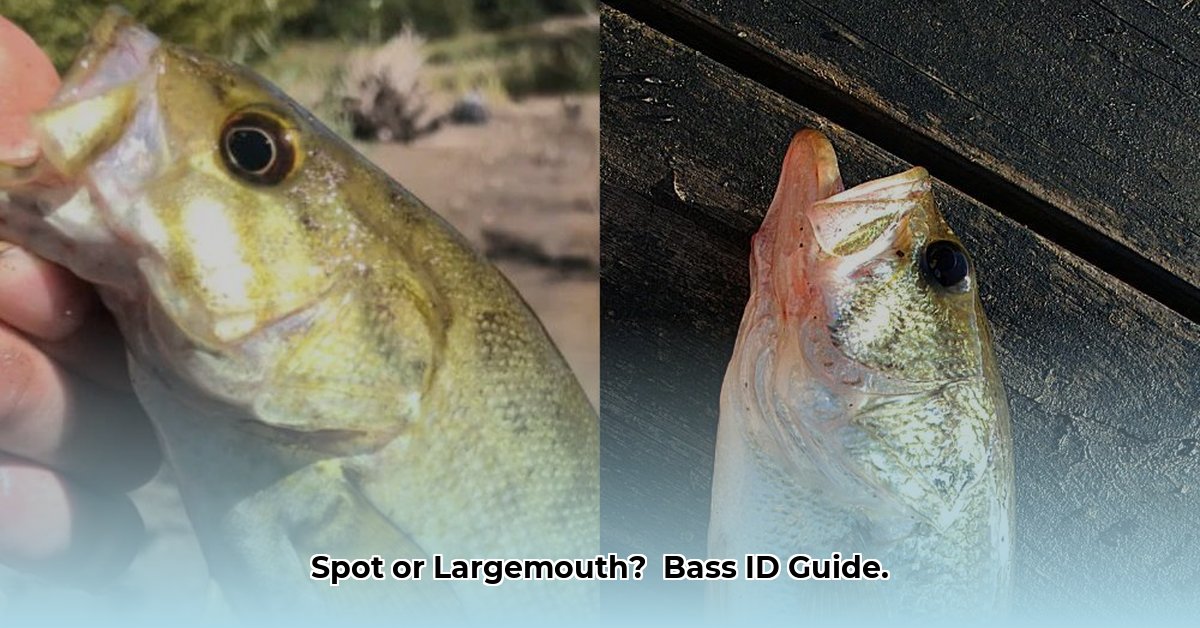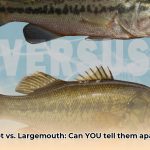This guide provides anglers of all levels with the tools to quickly and confidently distinguish between spotted and largemouth bass. Mastering these identification skills is not only satisfying but also essential for adhering to fishing regulations and practicing responsible angling.
Quick Visual Comparison: Spot the Difference
| Feature | Spotted Bass | Largemouth Bass |
|---|---|---|
| Jawline | Extends to, but not beyond, the rear of the eye | Extends distinctly beyond the rear of the eye |
| Cheek Scales | Noticeably smaller than body scales | Uniform in size with body scales |
| Dorsal Fin | Connected or barely separated | Distinctly separated, deep notch |
| Lateral Line | Often with a row of dark, broken spots | Faint line, fewer or no distinct spots |
| Tongue | Rough patch of teeth | Smooth |
| Belly Markings | Rows of dark spots, fading towards the belly | Few or no distinct spots |
Step-by-Step Identification Guide
1. The Jawline Test: The Quickest Tell
Gently hold the bass and examine its side profile. Imagine a vertical line extending down from the back edge of its eye.
- Spotted Bass: The upper jaw (maxilla) stops at or before this imaginary line.
- Largemouth Bass: The upper jaw extends beyond the imaginary line, giving it a characteristic “overbite.”
2. Cheek Scales: A Closer Look
Examine the scales on the fish’s cheek.
- Spotted Bass: Cheek scales are noticeably smaller than the scales on the rest of its body, almost like a patch of fine scales.
- Largemouth Bass: Cheek scales are uniform in size with the body scales.
3. Dorsal Fin: One or Two?
The dorsal fin, located on the bass’s back, provides another key clue.
- Spotted Bass: The dorsal fin has a shallow notch, appearing almost continuous, like one long fin.
- Largemouth Bass: The dorsal fin has a deep, distinct notch, giving the appearance of two separate fins.
4. Lateral Line: Follow the Spots
Observe the lateral line, a sensory organ running along the fish’s side.
- Spotted Bass: The lateral line is usually dark and clearly visible, often with a row of dark, sometimes diamond-shaped, spots. The line may appear broken or dashed.
- Largemouth Bass: The lateral line is typically fainter and less distinct, with fewer or no prominent spots.
5. Tongue Check: Rough or Smooth?
(Use caution and handle the fish gently.) Gently open the bass’s mouth and feel its tongue.
- Spotted Bass: The tongue has a rough patch of teeth.
- Largemouth Bass: The tongue is smooth. (Note: Some largemouth may have a small rough patch, so this is not a foolproof method.)
6. Belly Markings: A Final Check
Carefully turn the bass over and examine its belly.
- Spotted Bass: The belly typically has rows of dark spots that gradually fade towards the belly.
- Largemouth Bass: The belly has few, if any, distinct spots.
Habitat, Behavior, and Fishing Implications
While not definitive identification criteria, habitat and behavior can offer supporting clues.
-
Spotted Bass: Generally prefer deeper, clearer water with rocky structures and current. They are often found in schools and can be aggressive. They may be more likely to hit jigs, crankbaits, and plastic worms.
-
Largemouth Bass: More tolerant of shallower, murkier, vegetated areas. They are often solitary ambush predators and may be more likely to strike topwater lures, frogs, and spinnerbaits.
Regional Variations and Hybrids
Remember that regional variations in appearance exist within both species. Hybrid bass (a cross between spotted and largemouth) can further complicate identification, exhibiting a mix of characteristics. If you’re uncertain, consult local fishing regulations or contact your local fish and wildlife agency.
Regulations and Conservation
Always check and adhere to local fishing regulations, which may include specific size and catch limits for spotted and largemouth bass. Practicing catch-and-release helps ensure the health and sustainability of bass populations.
Frequently Asked Questions (FAQ)
-
Q: Which species fights harder? A: Both spotted and largemouth bass are known for their spirited fights, making them exciting to catch. Anglers often debate which fights harder, with some suggesting spotted bass are pound-for-pound more aggressive.
-
Q: Which tastes better? A: Taste is subjective. Both are considered good table fare, and preparation methods likely have a greater impact on flavor than species.
-
Q: What is the largest spotted bass ever caught? A: The current world record for spotted bass is 10 pounds 4 ounces, caught in California. State records vary. Check with your local wildlife agency for specific records in your area.
This guide equips you with the knowledge to confidently identify spotted and largemouth bass. Remember, ongoing research continues to enhance our understanding of these species. By continually learning and observing, you’ll become a more informed and successful angler. Happy Fishing!
- Who Gets Power From Grand Coulee Dam Across the Western US and - December 23, 2025
- Find Water Turbines for Sale for Hydropower Projects - December 22, 2025
- Hydroelectric Turbine for Sale for Clean and Renewable Energy - December 21, 2025
















